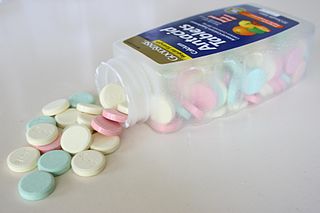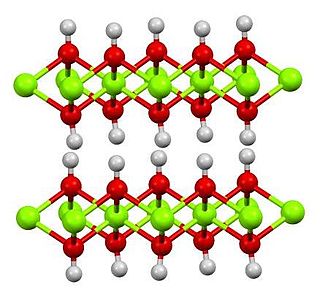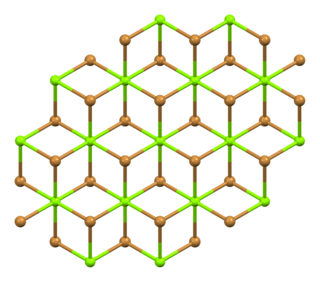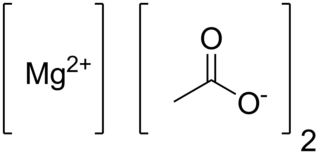
An antacid is a substance which neutralizes stomach acidity and is used to relieve heartburn, indigestion, or an upset stomach. Some antacids have been used in the treatment of constipation and diarrhea. Marketed antacids contain salts of aluminum, calcium, magnesium, or sodium. Some preparations contain a combination of two salts, such as magnesium carbonate and aluminum hydroxide.

Magnesium is a chemical element; it has symbol Mg and atomic number 12. It is a shiny gray metal having a low density, low melting point and high chemical reactivity. Like the other alkaline earth metals it occurs naturally only in combination with other elements and it almost always has an oxidation state of +2. It reacts readily with air to form a thin passivation coating of magnesium oxide that inhibits further corrosion of the metal. The free metal burns with a brilliant-white light. The metal is obtained mainly by electrolysis of magnesium salts obtained from brine. It is less dense than aluminium and is used primarily as a component in strong and lightweight alloys that contain aluminium.

Magnesium hydroxide is an inorganic compound with the chemical formula Mg(OH)2. It occurs in nature as the mineral brucite. It is a white solid with low solubility in water (Ksp = 5.61×10−12). Magnesium hydroxide is a common component of antacids, such as milk of magnesia.

Mathieu Pierre Flamini is a French former professional footballer and biochemical entrepreneur. A midfielder, he played for French side Marseille, English sides Arsenal and Crystal Palace, Italian side Milan and Spanish side Getafe. At international level, he was capped by the France national team on three occasions.

Tetraborane was the first boron hydride compound to be discovered. It was classified by Alfred Stock and Carl Massenez in 1912 and was first isolated by Stock. It has a relatively low boiling point at 18 °C and is a gas at room temperature. Tetraborane gas is foul smelling and toxic.

Magnesium nitrate refers to inorganic compounds with the formula Mg(NO3)2(H2O)x, where x = 6, 2, and 0. All are white solids. The anhydrous material is hygroscopic, quickly forming the hexahydrate upon standing in air. All of the salts are very soluble in both water and ethanol.

Levulinic acid, or 4-oxopentanoic acid, is an organic compound with the formula CH3C(O)CH2CH2CO2H. It is classified as a keto acid. This white crystalline solid is soluble in water and polar organic solvents. It is derived from degradation of cellulose and is a potential precursor to biofuels, such as ethyl levulinate.

Pyridazine is an aromatic, heterocyclic, organic compound with the molecular formula C4H4N2. It contains a six-membered ring with two adjacent nitrogen atoms. It is a colorless liquid with a boiling point of 208 °C. It is isomeric with two other diazine rings, pyrimidine and pyrazine.
Magnesium diuranate (MgU2O7) is a compound of uranium. It is known in the uranium refining industry as "MDU" and forms the major part of some yellowcake mixtures. Yellowcakes are an intermediate product in the uranium refining process.

Magnesium bromide are inorganic compounds with the chemical formula MgBr2(H2O)x, where x can range from 0 to 9. They are all white deliquescent solids. Some magnesium bromides have been found naturally as rare minerals such as: bischofite and carnallite.

Magnesium citrates are metal-organic compounds formed from citrate and magnesium ions. They are salts. One form is the 1:1 magnesium preparation in salt form with citric acid in a 1:1 ratio. It contains 11.33% magnesium by weight. Magnesium citrate is used medicinally as a saline laxative and to completely empty the bowel prior to a major surgery or colonoscopy. It is available without a prescription, both as a generic and under various brand names. It is also used in the pill form as a magnesium dietary supplement. As a food additive, magnesium citrate is used to regulate acidity and is known as E number E345.

Valonia is a genus of green algae in the Valoniaceae family. The genus Ventricaria is now regarded as a synonym of Valonia.

Anhydrous magnesium acetate has the chemical formula Mg(C2H3O2)2 and in its hydrated form, magnesium acetate tetrahydrate, it has the chemical formula Mg(CH3COO)2 • 4H2O. In this compound magnesium has an oxidation state of 2+. Magnesium acetate is the magnesium salt of acetic acid. It is deliquescent and upon heating, it decomposes to form magnesium oxide. Magnesium acetate is commonly used as a source of magnesium in biological reactions.

In organic chemistry, keto acids or ketoacids are organic compounds that contain a carboxylic acid group and a ketone group. In several cases, the keto group is hydrated. The alpha-keto acids are especially important in biology as they are involved in the Krebs citric acid cycle and in glycolysis.

2-Methyltetrahydrofuran (2-MeTHF) is an organic compound with the molecular formula C5H10O. It is a highly flammable, mobile liquid. It is mainly used as a replacement for Tetrahydrofuran (THF) in specialized applications for its better performance, such as to obtain higher reaction temperatures, or easier separations (as, unlike THF, it is not miscible with water). It is derived from sugars via furfural and is occasionally touted as a biofuel.

Diphenolic acid is a carboxylic acid with molecular formula C17H18O4. Its IUPAC name is 4,4-bis(4-hydroxyphenyl)pentanoic acid, and it can be prepared by the condensation reaction of phenol with levulinic acid in the presence of hydrochloric acid. The equation for this synthesis is:

α-Ketovaleric acid is a keto acid that is found in human blood. Unlike related keto acids, it is not an intermediate or metabolite associated with amino acids and its origin is unknown.
In organic chemistry, ketonic decarboxylation is a type of organic reaction and a decarboxylation converting two equivalents of a carboxylic acid to a symmetric ketone by the application of heat. It can be thought of as a decarboxylative Claisen condensation of two identical molecules. Water and carbon dioxide are byproducts:

Ethyl levulinate is an organic compound with the formula CH3C(O)CH2CH2C(O)OC2H5. It is an ester derived from the keto acid levulinic acid. Ethyl levulinate can also be obtained by reaction between ethanol and furfuryl alcohol. These two synthesis options make ethyl levulinate a viable biofuel option, since both precursors can be obtained from biomass: levulinic acid from 6-carbon polymerized sugars such as cellulose, and furfural from 5-carbon polymerized sugars such as xylan and arabinan.
5-Nonanone, or dibutyl ketone, is the organic compound with the formula (CH3CH2CH2CH2)2CO. This colorless liquid is a symmetrical ketone.

















